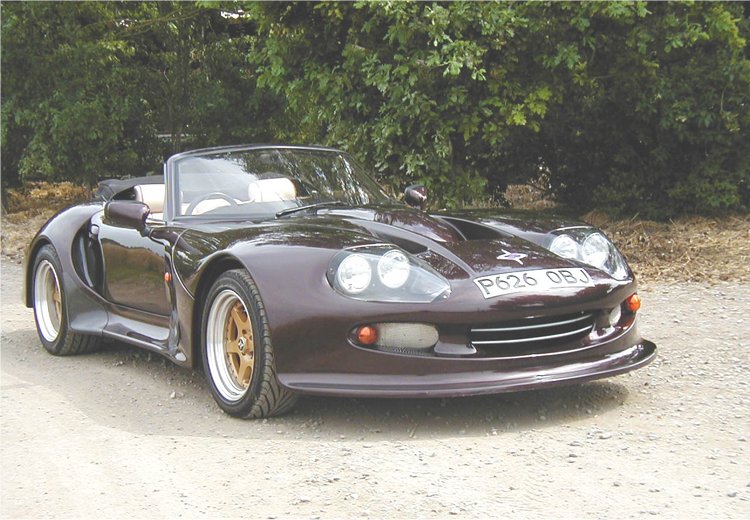Description
The Marcos LM 500 Spider was introduced in the mid-1990s as part of Marcos’s renewed push into GT racing and track-bred road machinery. It was a lightweight, open-top companion to the LM 400 and LM 600 coupés, and it reflected the company’s desire to build pure, competition-focused cars that could compete internationally while remaining usable by private owners. The LM 500 Spider was one of the most dramatic and purposeful Marcos models ever built, capturing the raw, analogue spirit of 1990s GT racing in a compact and beautifully balanced package.
The LM cars emerged during a revival period for Marcos, when the company returned to track competition after several quiet years. The LM 500 Spider shared the same square-section tubular steel chassis layout as the other LM models, but its open-top structure, reduced bodywork and lower mass gave it a noticeably different character. The chassis was extremely rigid, designed to withstand the high loads of GT racing, and it featured extensive triangulation for stiffness. Although heavier than the classic plywood monocoque cars of the 1960s, it offered far more strength, crash protection and flexibility for modern driveline and suspension setups.
The bodywork was moulded entirely from GRP and carbon-reinforced composites depending on specification. The Spider’s shape was dominated by its low nose, wide stance and short, open cockpit section. The front end featured the deep splitter and wide intake openings typical of 1990s GT racers, while the rear carried a distinctive tail section with cut-down sides and pronounced haunches over the rear wheels. With minimal mass above the waistline, the LM 500 Spider had an especially low centre of gravity and a clean aerodynamic profile suited to track use. It was visually aggressive, compact and instantly identifiable as a racing-derived machine.
Power came from the familiar Rover V8 engine, enlarged to 5.0 litres and tuned for strong mid-range torque. Depending on mapping, camshaft choice and induction system, outputs typically ranged from 300 to 340 horsepower. With the Spider weighing in the region of 900–950 kilograms, the car offered intense acceleration, a strong linear delivery and the characteristic V8 soundtrack that had become a Marcos hallmark. The engine was paired with a five-speed manual gearbox, most commonly a T5 or similar robust unit, delivering power to the rear wheels through a limited-slip differential.
The suspension followed proper motorsport engineering practice, with double wishbones and coil-over dampers at all four corners. Adjustable ride height, damper settings and camber allowed owners or race teams to tune the car for both road and competition. The LM 500 Spider had a firm, communicative ride and extremely sharp turn-in, with the chassis responding immediately to steering inputs. Braking was handled by ventilated discs all round with multi-piston calipers, offering powerful and consistent stopping capability suitable for track use.
Driving the LM 500 Spider was an intense and immersive experience. With no roof and minimal weather protection, the driver sat low in a cockpit dominated by exposed carbon mouldings and simple switchgear. The windscreen was small, and the proximity to the engine and road gave the car a raw, mechanical feel. Steering was quick and full of feedback, the brakes firm and reassuring, and the V8’s power delivery made the car feel explosive out of corners. On a circuit, the Spider’s stability and rigidity allowed it to push deep into braking zones and carry high speeds through long curves, behaving with the kind of planted confidence expected of a dedicated racing machine.
A small number of LM 500 Spiders were used in GT racing and one-make events, where they proved competitive thanks to their low weight, strong torque and durable chassis. Others were sold as road-legal track-day cars to dedicated enthusiasts. Production numbers were very limited, as Marcos hand-built each car to order and focused primarily on the more numerous coupé-bodied LM 400 and LM 600 models. As a result, surviving Spider examples are rare and highly valued.
Today, the Marcos LM 500 Spider stands as one of the most exotic and desirable models from the company’s 1990s renaissance. It combines the distinctive styling and engineering individuality Marcos was known for with the raw performance and racing pedigree of the LM programme. With its lightweight construction, torquey V8 engine and uncompromising open-top design, the LM 500 Spider remains one of the purest and most thrilling expressions of the Marcos philosophy: unconventional, involving and built for drivers who wanted something genuinely different.
